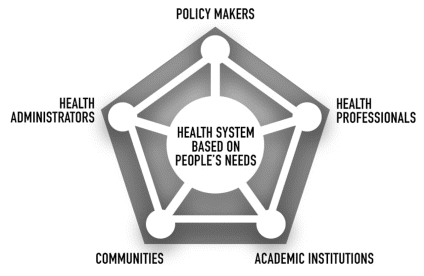
Figure 1 Social accountability partnership pentagram2
Amy Clithero-Eridon PhD 1, Pauline Sameshima PhD 2, Erin Cameron PhD 3, Jill Allison PhD 4, Julia Martinez MS 5, Tashya Orasi 6, Connie Hu BS 7, Roger Strasser MBBS MClSc 8
1Principal Lecturer, University of New Mexico School of Medicine, Department of Family & Community Medicine, Albuquerque, New Mexico, United States
2Professor and Canada Research Chair in Arts Integrated Studies, Lakehead University, Thunder Bay, Ontario, Canada
3Associate Professor and Director of the Centre for Social Accountability, Northern Ontario School of Medicine, Thunder Bay, Ontario, Canada
4Clinical Assistant Professor, Faculty of Medicine Memorial University of Newfoundland, Newfoundland and Labrador, Canada
5Qualitative Research Specialist, Clinical and Translational Sciences Center, University of New Mexico Health Sciences Center, Albuquerque, New Mexico, USA
6Artist-Researcher, PhD Candidate, Leadership & Policy Studies, Faculty of Education, Lakehead University, Thunder Bay, Ontario, Canada
7Medical Student, University of New Mexico School of Medicine, Albuquerque, New Mexico, USA
8Emeritus Professor of Rural Health, University of Waikato, New Zealand, Hamilton, New Zealand and Founding Dean Emeritus, Northern Ontario School of Medicine, Ontario, Canada
ABSTRACT
Background: This project aimed to build an understanding of the lived realities of social accountability. The COVID-19 era offered a contextual lens and time marker. Social accountability is gaining importance as an educational concept. To maximize the value, it is essential to know how the concept is interpreted from multiple stakeholder perspectives. Methods: An arts-integrated methodology called Parallaxic Praxis was used to examine the values, meanings, contexts, and lived experiences of social accountability. Participants made art to express and discuss their conceptions of social accountability, viewing and discussing the subtleties and themes that arose from their own and others’ creations. Individual interviews, focus groups, and post-workshop surveys were utilized to identify themes. Results: Due to the timing of the data collection during the COVID-19 pandemic, interpretations of social accountability centered primarily on the pandemic’s effects on perceptions of daily life as well as core personal beliefs. Most individuals viewed medical schools as a place of opportunity to start learning about social accountability, and the majority of individuals answered “yes” when asked if exploring the idea and action of social accountability through arts-integrated methods was valuable to them. Discussion: If the ultimate goal of medical education is creating physicians who are fit-for-purpose, then social accountability needs to be emphasized and reinforced as an important part of their professional identity. Integrating the arts in data collection is a creative means to conduct this study, as the arts allow for diverse audiences to access active and reflective engagement among participants. As a method of expression, it provided additional unique perspectives on one’s own beliefs regarding social accountability and how it is practiced—and what is expected of a socially accountable health system.
Keywords: Social accountability, Parallaxic Praxis, medical education, community engagement, arts and medicine, healthcare workforce
Date submitted: 30-May-2022
Email: Amy Clithero-Eridon (AClithero@salud.unm.edu)
This is an open access journal, and articles are distributed under the terms of the Creative Commons Attribution-Non Commercial-Share Alike 4.0 License, which allows others to remix, tweak, and build upon the work non-commercially, as long as appropriate credit is given and the new creations are licensed under the identical terms.
Citation: Clithero-Eridon A, Sameshima P, Cameron E, Allison J, Martinez J, Orasi T, et al. Deepening understandings of social accountability using the arts and storytelling. Educ Health 2024;37:39-49.
Online access: www.educationforhealthjournal.org
DOI: 10.62694/efh.2024.30
Published by The Network: Towards Unity for Health
Social accountability was conceptualized by the World Health Organization as the obligation of medical schools to direct their research, education and service activities towards addressing the priority health concerns of a country, region, and/or community. However, social accountability has largely been documented at an institutional level, without understanding the lived realities of the people in a community. This project aimed to describe the lived realities of social accountability, beginning with participants in New Mexico (USA), Northern Ontario (Canada), and Newfoundland and Labrador (Canada) and expanding outwards to other sites (not included here) to understand—at both a local and global level—the nuances and intricacies surrounding the concept.
There is a significant investment by students and society in creating healthcare providers who have both the technical expertise and a set of professional values that includes a service orientation and ethical commitment not only to their patients, but the communities in which they practice. Social accountability is a competency-based value that is best demonstrated by providers who act as change agents in partnership with their communities.1 This leads to a shared understanding and mutual goals to address inequities and priority health concerns of the community. Although there are many examples available online for the partnership pentagram used to conceptualize perspectives in social accountability, the British Columbia Rural and First Nations Summit Summary Report provides an excellent example of the diversity of perspectives needed to advance socially accountable health system transformation (Figure 1: Social accountability partnership pentagram).2

Figure 1 Social accountability partnership pentagram2
Social accountability is gaining importance as an educational concept. To maximize the value, it is essential to know how the concept is interpreted from multiple stakeholder perspectives. This is one reason why community members were invited to participate in this project. Although the term has been described, operationalized, and “defined,” social accountability is not universally well understood, even within medical schools.3 Social accountability is both an institutional and personal responsibility. It is not solely academic learning, nor does it replace technical skills. While the literature focuses on strategies to achieve socially accountable outcomes, the notion is also intangible, such as personal values and a culture of caring for both individuals and the community.4–6
Arts-integrated activities in medical education have been used to develop medical students’ “observational, interpretive skills and empathic abilities.”7 In another study, “most students considered art to be a valuable tool to learn medicine,” as all medical fields require recognition and interpretation of visual cues to form diagnoses.8
Researchers and educators from four international post-secondary institutions worked collaboratively with medical students, allied health professionals, faculty, educational leadership, and community organizations through arts-integrated strategies to explore the meaning and practices of social accountability. The objectives of this research were to: (1) recognize the different perspectives and meanings of social accountability; (2) describe the different ways social accountability is experienced and storied; and (3) explain the strengths of using arts-integrated approaches in health professional education.
We used an arts-integrated methodology called Parallaxic Praxis to examine the values, meanings, contexts, and lived experiences of social accountability.9 As a methodology that “leverages the researcher’s personal strengths and the collective experience of the team, including the participants and community when possible,” the different phases of Parallaxic Praxis (data, analysis, rendering) provided opportunities to collect data through art-making, structured interviews, and surveys. It invited individuals to explain the meaning of social accountability through their art and extend their thinking by interpreting each other’s visual representations. Parallaxic Praxis is a methodology that values multiple perspectives, offers ways to generate new thinking through metaphors and material creations, and creates equitable space amongst various stakeholders for these conversations to happen.9
In this paper, we report on data collected at three international post-secondary institutions. Due to COVID-19 restrictions and timing, there were variations in the way the data was collected at different sites; however, Zoom technology was incorporated, and participants met in small groups (3–4 persons). Some groups created art during the Zoom session just prior to the discussion; other groups completed their artworks in their own time and then met within a small group setting at a later date. The group format differed depending on time constraints, but in general, it lasted two to three hours. The art mode was not pre-defined for participants. Thus, visual representations could be drawings, paintings, sculptures, collages, images found in magazines or online, or any form participants chose. Art skills did not create participation bias as participants chose their own mode of representation. Art supplies were not provided to participants.
Participants, who included community members, medical students, physicians, non-clinical faculty, and Deans, created art representations of social accountability within small groups. All participants were over the age of 18. Participants were recruited via social media strategies and email, and for community member participation, we posted flyers at strategic sites and made announcements on websites and public radio stations. Participants were incentivized to participate through the offer of a merchandise card for randomly selected participants post-participation. Once participants were selected, they were emailed pre-information preparatory information (Table 1: Participant preparatory information).
Table 1 Participant Preparatory Information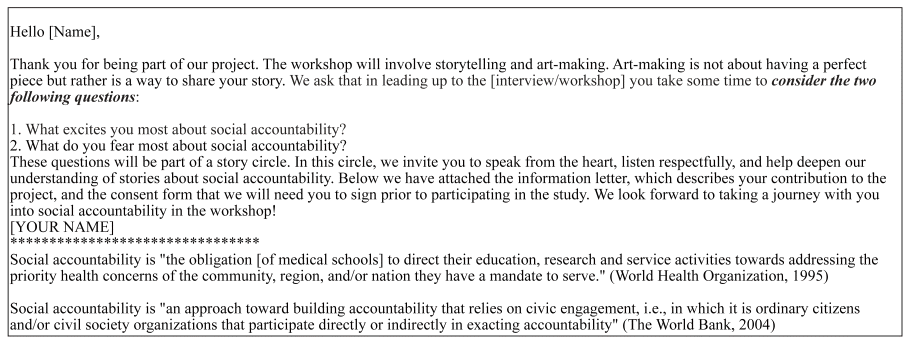
A conversation circle began the workshop to help express people’s fears and excitement surrounding both the phrase and the concept (Figure 2: Circle of trust touchstone). Participants then delved deeper into meanings by creating art around their conversation about what social accountability means to them, to the healthcare system, and to medical education. Art Analysis: Research team members from diverse fields interpreted the data through their disciplinary expertise using an analysis procedure called the “Catechizations Process,” a way to move knowledge further through systematic questioning. The artworks are used as touchstones to provoke thinking and generate discussion. At each site, researchers, research assistants, and an artist team member assigned to each site participated in the catechization analysis to seek deeper understanding expressed through the participants’ artwork. This process was carried out in two formats: 1). The group facilitator provided the catechization theme word, described the word, and encouraged discussion to evolve based on the key theme or 2). A worksheet was provided to the participants with a few of the catechization themes, and participants wrote notes and ideas on the sheet before group sharing began. In both cases, a selection of 4–5 of the catechizations was used. (Table 2: catechization definitions).
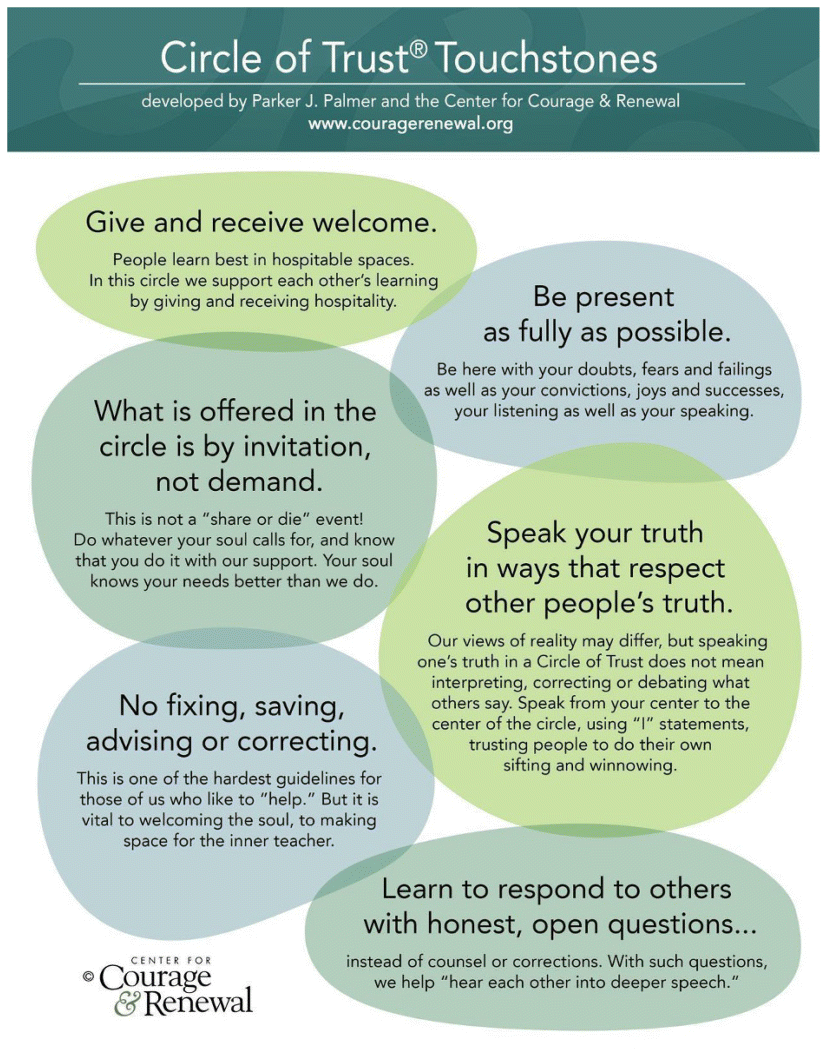
Figure 2 Circle of trust touchstones
Table 2 Catechization Questions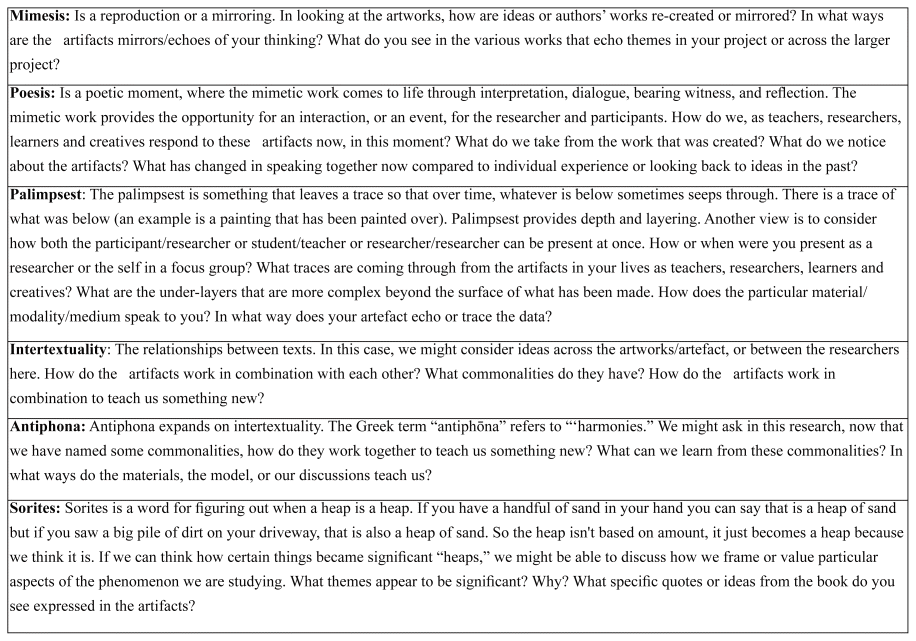
After the artworks were made, participants viewed each other’s art and discussed the subtleties and themes that arose from their creations. Questions were asked by the researchers, and answers were recorded and transcribed. (See Table 3 for a complete list of questions asked of participants). Interviews were conducted by a study team member through Zoom teleconferencing software and were audio recorded and professionally transcribed.
Table 3 Questions asked of workshop participants*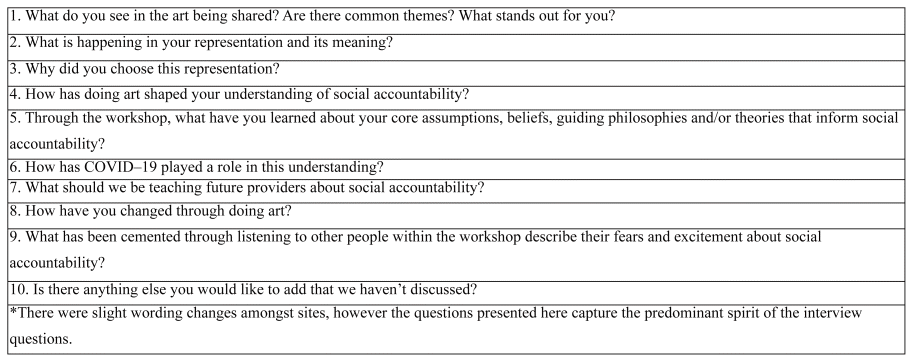
Immediately after the artwork activity and interviews, participants at three of the sites were asked to complete a post-survey via email. Participants received a $10 merchandise card as compensation for their time. (Table 4: Post-Workshop Questions)
Table 4 Post-Workshop Questions
The study team collaborated with a qualitative methodologist (JM) at the UNM Clinical and Translational Science Center (CTSC; https://hsc.unm.edu/ctsc) to analyze interviews and surveys. The analyst used a thematic, iterative process to create codebooks and manually code transcripts using NVivo software.10 Upon completion of coding, NVivo was used to perform matrix queries to identify quote density across codes.
The research project was approved and exempted by individual site institutional IRB review boards: UNM HRRC #20-291, NOSM (Lakehead University #1467908; Laurentian University #20201104), MUN HREB # 2020.078.
Sixteen interviewees from New Mexico participated in the interviews. The following results reflect four themes based on responses to the question: “How has doing art shaped your understanding of social accountability?” Because of the timing of the data collection, interpretations of social accountability were centered around the COVID-19 pandemic’s effects on perceptions of daily life as well as core personal beliefs. This use of context helped to ground the discussion in concrete examples of social accountability. Based on a qualitative analysis of themes, 16 interviewees shared how the arts-integrated methodology has shaped their understanding of social accountability. Half of the participants (N, 8) responded that the process made them think “differently” or “deeper” about social accountability. One interviewee reflected on the pandemic’s effects on the perception of daily life: “It made me think harder at how and why I think about Covid and social isolation and social accountability.” Another respondent shared, “This art made me think about it. Usually, I’m not artsy and don’t usually enjoy looking at art but drawing in your expectations makes you think a lot deeper into it.” A few participants (N, 4) shared how this process helped them better understand social accountability and how the concept is now more concrete and clearer with the use of visual representations. Observations included: -”I think it made it more concrete. It can be abstract especially in sociology and overwhelming on a societal level. On an individual level it made it clearer.” -”Writing it down made it easier to understand what social accountability is. It helped to draw and think it through.”
Three participants felt more aware of social accountability within different settings, such as medical environments, schools, and communities. Two participants highlighted how they were able to see and learn from other perspectives. For example, “Art shows you other ways of thinking that are different than yours. You have a basis of understanding of your own, but when you see others’ art, it can change your interpretation…” and, “It was interesting to see a snapshot of what other people were thinking.”
The analysis of 31 post-survey results from New Mexico, Newfoundland, and Northern Ontario was included in this summary. The following results reflect the following questions: “Was this your first experience with arts-based methods?”; “Did this arts-based method clarify what social accountability means, and how?”; “Did the process change your perception of social accountably overall?”; “Did the process change or reaffirm your view of social accountability within your role as a healthcare provider?”; “Did the process change or reaffirm your view of healthcare providers within the context of social accountability (their roles and your expectations)”; “When you reflect upon social accountability, did the process change or reaffirm your view of the healthcare system?”; “Did the process change or reaffirm your view of medical education and the role of social accountability (how it is/isn’t taught)?”; and “Was exploring social accountability through an artsbased method valuable to you?”
For 84% of participants (N, 26), this was their first experience with an art-integrated method.
Most participants (12/31; 39%) mentioned that the arts-integrated method has made them contemplate what social accountability means to themselves. One person said, “I think the arts-based methodology was helpful for contemplating what social accountability means to oneself in order to convey this meaning in a visual (or other) medium.” Some participants (10) shared comments about expressing social accountability to an audience in an art form has been a different way of presentation: “By switching off the “language brain” and starting to think about things in terms of imagery, I was able to connect more emotionally with the content of our discussions and to ‘see’ more clearly how I consider social accountability. For me, it is often representing something visually that helps me better understand what I really think about it.”. A few participants (7) shared how the arts-integrated process has made them think in a different way about social accountability, for example, one participant said, “This meant that I then utilized more imagery and took deeper strives to understand / engage in discussions—and try and visualize SA in a more nuanced way.”
When asked how the arts-integrated methodology has changed their perception of social accountability, overall, 12 participants shared that the methodology had allowed them to contemplate what social accountability means to themselves. One person states: “Yes: prior to this exercise, I conceptualized social accountability more as a thing, a way of being or practicing that an individual or institution should strive towards. However, taking part in the discussion and accompanying arts-based method of this workshop helped me to reconsider social accountability more as a process—a way in which one should work.” Other participants (10) shared how this process helped them see the complexities of social accountability and how the concept can be woven into everyday interactions. One person said, “It gave me the ability to more fully embrace the notion that our connections with society will never be straightforward. I could also truly see, when the artwork was finished, that we are all interwoven into a social fabric that units us—every one of us is therefore accountable to the other.”
When participants were asked if the process has either changed or reaffirmed their view of SA within their role as healthcare providers, 45% mentioned the process reaffirmed their view, and 29% said it changed their view. A few participants (8) spoke about the importance of SA in healthcare settings and the responsibilities that exist within different roles. One person shares: “As a healthcare provider, my view of social accountability has changed and become broader. I have realized that social accountability is entrenched in every facet of healthcare. Discrepancies in the care of people from various races, ethnicities, genders, socioeconomic strata, and religions demonstrate how our healthcare system fails many individuals in society.”
When participants were asked if the process has either changed or reaffirmed their view of healthcare providers within the context of social accountability (roles and expectations), 52% mentioned the process reaffirmed their view, 29% said it changed their view, and 23% shared that they were unsure. Many participants (61%) expressed the importance of SA in healthcare settings and shared their expectations towards providers relating to SA. For example, “Yes, it reaffirmed my view. Since healthcare providers are directly working with human lives, I expect my healthcare providers to keep social accountability as a top priority even more.” Another person shares their understanding of SA, “I gained the understanding that social accountability of health care workers is necessary and contributes to a lot of other aspects of a functioning community.”. Other individuals (29%) mention how the arts-based process addresses the complexities of SA. One person mentions how they see SA in the role of a healthcare provider: “I think it broadened my view of healthcare providers within the context of social accountability. When I considered the question for this project, I considered how ingrained healthcare providers are in their community and the connections we all have to our community. I ended up feeling that all people have a role in socially accountable systems, regardless of their job description.”
Participants were also asked to reflect upon SA and if the creative process has either changed or reaffirmed their view of the healthcare system: 55% mentioned the process reaffirmed their view, 23% said it changed their view, and 26% shared they were unsure. Many participants (45%) expressed the importance of SA in healthcare settings and provide personal insights within the system they work. One person shared, “Yes, this made me realize that doctors, pharmacists, nurses, etc., should prioritize social accountability. Therefore, healthcare systems should not focus on anything else outside of that. Healthcare systems should not compete for more profits, be political, or bureaucratic.” Others (29%) address the complexities of SA in healthcare systems, for example, one person expresses, “Health care is quite nebulous, with many agents acting at different points in space and time, all with separate influences that have a large cumulative magnitude. Thus, instead of placing the onus on “the system” and relinquishing personal responsibility, I think that if individuals at all levels of health care followed a culture of social accountability, there would be a major beneficial impact.”
Most individuals (61%) viewed medical schools as a place of opportunity to start learning about SA. One person mentioned how faculties of medicine should be examples of SA by modeling and teaching students: “I feel faculties of medicine (and medical schools) have both direct mandates to the communities they serve but also to the future of these communities, by training medical professionals to act in a socially accountable manner.” One person shared how they haven’t received education in SA within their medical school and how they needed to search for what SA meant: “While doing this project, I realized that social accountability is something that has not really been touched on within our first two years of medical school, so I found myself looking up definitions to get a better idea of what it meant.”. Some participants (23%) highlighted the importance of SA in healthcare in medical education. One individual states: “As I am on the cusp of graduating from medical school, I approached the discussion, and the process, by placing MYSELF in the role of a healthcare provider—and all envisioning of contexts and situations involved a personalization and projection. THIS, I think, in partnership with the process of expectations of the arts-based production, created a very deep and meaningful reflection throughout the exercise, which ultimately clarified my expectations of myself and understanding of the complexity of SA and HCP, as well as that of our medical education system, larger, institutional health care systems, and the overarching governing systems (provincial and national).”
The majority (71%) of individuals answered “yes” when asked if exploring SA through arts-integrated methods was valuable to them, 3% said “no”, 3% said “sort of” and 6% were “unsure”. Many people (45%) mentioned the arts-integrated method was presented in a different way and allowed opportunity for engagement. One participant mentioned, “I think arts-based methods provide an important opportunity for participants to engage different ways of thinking about topics that are valuable at both the individual and group levels. (I mean that literally, in the sense that arts-based methods embedded in other forms of more traditional research methods, engages different neural pathways and cognitive mechanisms, and that difference makes becoming aware of multiple perspectives on a topic a much easier goal to reach).” Other individuals (39%) share how this method allowed them to contemplate SA in meaningful reflection, for example, one participant shares, “The expectation of the ‘creation’ at the end necessitated an element of meaningful reflection, and analysis, which I think is missing in other methods.”
Although this project had a small sample size, the results indicate that art is a unique method to explore the meaning of social accountability, for a deeper understanding and appreciation of its importance to providers and community members within the healthcare system. This research facilitates: “Raising awareness in health professionals’ schools of how their learners experience social accountability (to allow) for the development of more targeted and effective strategies and programs to create a fit-for-purpose workforce.”11 If the ultimate goal of medical education is creating physicians who are fit-for-purpose, then social accountability needs to be emphasized and reinforced as an important part of their professional identity. Often, social accountability is defined by both practitioners and community members as: “being accountable to society,” which is really just a repetition of the term.12 Visual representations can make the concept more tangible by exploring the nuances, values, and meaning of social accountability.
Art takes time to create, and explaining why individual pictures were selected, or representations created, can reconnect students to their purpose and help align care to meet community and patient needs. Art as a data collection method is a creative means to conduct this exploration as it is accessible to diverse audiences and allows for active and reflective engagement from participants. Applying arts-integrated methodologies into medical education is useful to assist students in expressing their own unique perspectives and beliefs of social accountability, how it is practiced, and what is expected of a socially accountable health system. Sharing these perspectives alongside community members using visual representations can lead to larger group understanding of expectations, and perhaps new insights into provider roles in meeting community needs.
This project is supported by awards from the National Center for Advancing Translational Sciences, National Institutes of Health (Grant Number UL1TR001449) and a New Frontiers Grant. (Cameron, PI).
1. Boelen C, Heck J. Defining and Measuring the Social Accountability of Medical Schools. WHO/HRH/95.7, Geneva: World Health Organisation, 1995. http://doi.org/10.4300/JGME-D-12-00274.1
2. Woollard RF. Caring for a common future: medical schools’ social accountability. Medical Education 2006; 40: 301–313. http://doi.org/10.1111/j.1365-2929.2006.02416.x
3. Preston R, Larkins S, Taylor J, et al. From personal to global: Understandings of social accountability from stakeholders at four medical schools. Med Teach 2016; 38: 987–994. http://doi.org/10.3109/0142159X.2015.1114596
4. Boelen C. Adapting health care institutions and medical schools to societies’ needs. Acad Med 1999; 74: S11–20. http://doi.org/10.1097/00001888-199908000-00024
5. Rourke J. Social Accountability: A framework for medical schools to improve the health of the populations they serve. Academic Medicine 2018; 93: 1120–1124. http://doi.org/10.1097/ACM.0000000000002239
6. Elsanousi S, Elsanousi M, Khalafallah O, et al. Assessment of the social accountability of the Faculty of Medicine at University of Gezira, Sudan. East Mediterr Health J 2016; 22: 258–266. http://doi.org/10.26719/2016.22.4.258
7. Cox SM, Lafrenière D, Brett-MacLean P, et al. Tipping the iceberg? The state of arts and health in Canada. Arts & Health 2010; 2: 109–124. http://doi.org/10.1080/17533015.2010.481291
8. Cracolici V, Judd R, Golden D, et al. Art as a learning tool: medical student perspectives on implementing visual art into histology education. Cureus 2019; 11: e5207. http://doi.org/10.7759/cureus.5207
9. Sameshima P, Maarhuis P, Wiebe S. Parallaxic Praxis: Multimodal Interdisciplinary Pedagogical Research Design [Hardback, Premium Color]. Vernon Press, https://vernonpress.com/book/441 (2019, accessed 10 September 2021).
10. NVivo. Lumivero, https://lumivero.com/products/nvivo/ (accessed 5 July 2023).
11. Woolley T, Clithero-Eridon A, Elsanousi S, et al. Does a socially-accountable curriculum transform health professional students into competent, work-ready graduates? A cross-sectional study of three medical schools across three countries. Medical Teacher 2019; 1–7. http://doi.org/10.1080/0142159X.2019.1646417
12. Clithero-Eridon A, Albright D, Ross A. Conceptualising social accountability as an attribute of medical education. African Journal of Primary Health Care & Family Medicine; 12. Epub ahead of print 18 February 2020. http://doi.org/10.4102/phcfm.v12i1.2213
© Education for Health.
Education for Health | Volume 37, No. 1, January-March 2024